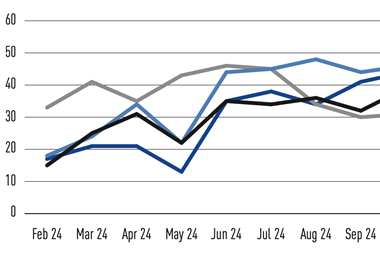In France, the acronym rules. Often the mightiest institutions hide coyly behind a few stark letters. This is nowhere more true than in the case of CDC.
Caisse des Dépôts et Consignations is a colossus of French public sector financial life, a group containing the country’s leading life insurer, its largest custodian, one of the biggest money managers and a major pooled investment vehicle provider.
Its other activities include administering the retirement programmes for one in seven French retirees. This area is headed by Bernard Cochemé, senior executive vice president for the department and a member of CDC’s executive committee. Because of CDC’s public nature, we mainly manage public retirement schemes, for example, we look after those for statutory civil servants in local authorities and hospitals.”
The three main public sector arrangements looked after cover over 5m active and retired members in both primary and supplementary schemes. France’s main civil service scheme is run separately by the finance ministry. Nonetheless, CDC’s figures are massive. “In 1996, the amount of contributions and pay-outs totalled more than Ffr50bn ($9bn),” Cochemé says.
“We use all the different techniques, not just the ‘distributive’ pay-as-you-go system. Some are annuity-based, others are on retirement points, while a number are fully funded,” says Cochemé. But in terms of cash flow about 90% can be attributed to the PAYG systems, which means that only a small proportion is retained for investment. “In 1996, this was around Ffr7bn.”
The actual investment is handled by the group’s investment arm, CDC Gestion. “But we keep the strategy in-house. Our treasurers aim to match the assets with liabilities. They know when they will need the funds and the amount of funds that will be coming in.” The bulk will be in fixed interest-related investments, but up to 15% can be in stocks. “For fixed interest, we set the precise constraints, for example the duration, or which segment of the interest rate curve.”
On the equities side, it depend on the funds’ situation. “If the fund accumulates reserves, we reckon we can take the risk to invest in stocks, particularly if the markets are good.” But as a public sector organisation its results will be monitored by the government. Also, the government can be involved in another way. Cochemé explains: “Sometimes the government will withdraw this money in orderto supplement the resources for other pensions schemes. So whenever the funds have accumulated reserves we have to take into account possible action from the government. We have to structure the portfolio in a way that would be compatible with withdrawals.”
Last year the 15% of the portfolio invested in equities produced a 32% return, outperforming the CAC 40 index. This was achieved by investing in medium-sized companies, a sector that performed very well last year, explains Cochemé. While the asset allocation strategy is decided in-house, the decision to go, say, mid-cap is more iterative. “What we say to the managers is that we are prepared to take more risk on 15% of the portfolio, it is up to you to decide which sector or segment of the market.” CDC Gestion responded that in its view mid-caps would perform better than other stocks. “We take the initiative in common.”
While there are no constraints as to where the funds are invested, they are not likely to stray from France, with investments in other European equities being through those listed on the Paris Bourse. “As far as currency matching is concerned, we tend to avoid currency exposure as our liabilities are in French francs.” In money management the same rules do not apply as in the insurance sectors. “French insurers, because of congruence, must not expose themselves by more than 20%,” says Cochemé, who believes it will become easier in the future to invest in other countries.
The funded schemes are much smaller, with assets totalling about Ffr300m. “This part of business is open to the market and we obtain the administration following a public tender.” The Fonpel scheme for elected municipal representatives, one of France’s first pension funds, was started in 1993. “The details were published in the papers and the companies that won the business did so because they were considered the best in the field.” CDC was granted the administration, and its life arm CNP was one of the four insurance companies awarded the asset management mandates. Next time around, the process will be done under the European tendering rules.
Cochemé observes that this fund’s structure is in a form that will be familiar to Anglo-Saxons, with investment managers reporting directly to the fund’s board, composed of member representatives. “We not only have auditors, we have actuarial consultants as well!” CDC as administrator becomes involved with the collection of the contributions and distribution of these to the asset managers and then reporting every three months to the board, both on the administration and investment aspects.
He see more of this type of arrangement in future. “People realise that with funded schemes, there are more risks as well as returns, so the type of organisation that is used just to collecting and redistributing money is no longer appropriate to the challenges posed by funding. They are more complex by nature and people are realising that they they will need expertise, money management skills, administrative professionals and consultants.”
The new pensions law will help this process along, Cochemé believes, despite its difficult birth. “I think it was the best we could do according to the mood of the debate.” He believes that it was much too early to try to create an entire special code for pensions. “We expect some changes in the coming months or years in order to adopt accurate rules for pensions funds.” In time, things will develop.
Cochemé points to an apparent contradiction in the French approach to pensions. “People appear as individualistic, but in fact for everyday life they like to have laws and a protective shell. Even if they behave in an individualistic manner in their lives, they like the idea of the state taking care of them.”
As a retirement scheme administrator, he notes another anomaly. “In discussion, it is said there is a frontier between public and private management. But in fact this is not so, because even if the system is PAYG, an important part of pension provision is administered not by the state, but by private entities. What wecall the second level of pensions is managed by employers and employees - the unions. The state does not run the second level.”
Originally, the second level could have been established and run on a funded pension basis, he explains. “When the system was being set up in the 1950s, this question was asked and employers answered that they preferred to have the money in the company than in the retirement schemes.” Later when the the question was asked again, the same response was given. “But if the story had been different, we could have had the second pillar funded completely now.”












No comments yet